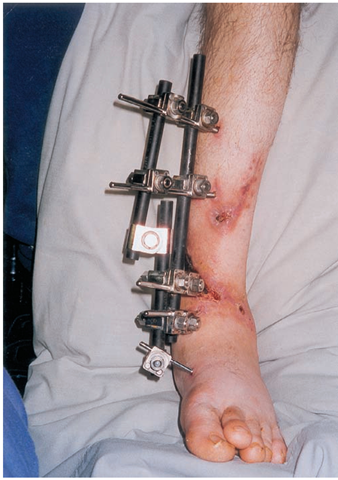
Traction is a pulling force exerted on bones. There are many reasons traction is applied to a patient such as preventing deformities, reducing muscle spasm, and immobilizing fractures.
On NCLEX there are 2 types of traction that you must know:
1. Skeletal
2. Skin
Skeletal traction

Skeletal traction is where the traction is applied direction to the patient's bones using pins, wires, or tongs. This is done surgically. This requires the nurse to provide pin care and assess the skin frequently for any redness, drainage, or odor at the surgical site. Cleaning the pin insertion site is done according to hospital policy. Weights are used to call the traction "balanced".
Thomas splint is usually used with skeletal traction.

*Thomas Splint Traction Notes: Pad the top off the splint. Hip should be flexed at 20 degrees. A footplate may be needed to prevent foot drop.
Other NCLEX priorities for skeletal traction:
Do not rest affected limb on foot of bed
Plantar flexion & dorsiflexion exercises are good.
Use overhead trapeze to assist with moving
Skin Traction

In skin traction weights are attached to an elastic strip and then secured by another device so that the affected limb can be covered. No surgery is needed.
There are two types of skin traction you want to know for NCLEX.
1. Buck's extension
2. Russell traction
Buck's Extension

Buck's extension uses weights to pull straight on the affected extremity. Normally seen in patients with a:
- fractured hip
- fractured knee
- fractured femur
Monitor patient does not slide to foot of bed. "Shock blocks" may be used to help this not to happen.
Bed should not be placed in high fowler's position.
Russell's Traction

Russell's traction requires the knee to be suspended in a sling that is attached to a rope or pulley. This will create an upward pull from the knee. Weights are also attached to the foot of the bed like Buck's extension. This is generally used to stabilize fractures of the femur before surgery.
Russell's Traction Notes:
- Head of bed should be flat.
- Foot of bed can be slightly elevated.
- Watch for DVT as pressure is on popliteal space.
- Pad the sling.
- Clients may turn slightly from side to side without moving body below the waist.
Other NCLEX general priorities for traction:
- Do not rest affected limb on foot of bed
- Plantar flexion & dorsiflexion exercises are good.
- Use overhead trapeze to assist with moving
- Nurse may need to make bed from Head to Foot.
Great post I must say and thanks for the information. Education is definitely a sticky subject. it is still among the leading
ReplyDeletetopics of our time. I appreciate your post and looking for more.
Most Comfortable Airplane Pillow.
Thanks for the information. It was well explain!
ReplyDelete